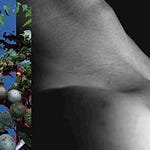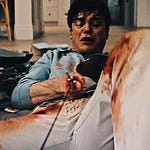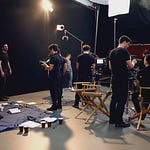In a twist worthy of his own science fiction, the director who once warned us about machine sentience in 'Terminator' now knows the truth: creativity is no longer a human monopoly—and he's betting his legacy on artificial intelligence.
In a moment of surprising vulnerability, he recently admitted feeling "queasy" about the proliferation of "in the style of…" AI prompts that have flooded the internet, particularly in the wake of Studio Ghibli-inspired image generations. The irony? Cameron immediately undermines his own discomfort by revealing the internal creative process he's always used.
"I think we should discourage the text prompt that says, 'in the style of James Cameron,' or 'in the style of Zack Snyder,'" he declared on a recent podcast. And yet, in the same breath, he candidly confessed: "I aspire to be in the style of Ridley Scott, in the style of Stanley Kubrick. That's my text prompt that runs in my head as a filmmaker."
"I think we should discourage the text prompt that says, 'in the style of James Cameron,' or 'in the style of Zack Snyder,'" he declared on a recent podcast. And yet, in the same breath, he candidly confessed: "I aspire to be in the style of Ridley Scott, in the style of Stanley Kubrick. That's my text prompt that runs in my head as a filmmaker."
The contradiction is delicious. Cameron's internal creative process—"In the style of George Miller: wide lens, low, hauling ass, coming up into a tight close up"—is essentially the same algorithmic mimicry he finds troubling when performed by AI. "Yeah, I want to do that. I know my influences. Everybody knows their influences," he said, unwittingly revealing the fundamental similarity between human and artificial creativity.
When sound arrived in Hollywood, silent-film actors weren't invited to "move onto cool things"—many faced unemployment overnight. Now, Cameron presents AI as just another technological tool, a perspective that echoes earlier moments of industrial "progress" that systematically erased creative livelihoods.
In a philosophical sleight of hand, Cameron dropped a provocative metaphor: artists are essentially "models" trained on life experiences. Behind Cameron's vision of "efficiency" are real human stories of potential displacement.
Yet, dismissing AI purely as a threat overlooks its genuine creative potential. Algorithms aren't inherently antagonistic to artistic expression; they can be powerful collaborators, offering artists new methods to experiment, iterate, and discover novel forms. Imagine a world where AI liberates filmmakers from tedious repetition (rotoscoping!?), enabling them to focus entirely on imaginative storytelling. Visualize an animator who, rather than being displaced, leverages AI to bring previously impossible narratives to life—stories crafted from dreams too ambitious, expensive or technically daunting to pursue traditionally. AI, if thoughtfully harnessed, could amplify creativity by expanding our capacity for imaginative exploration and risk-taking.
However, realizing AI's positive potential requires careful navigation of ethical, economic, and creative boundaries—something a cost-cutting, efficiency-first approach dangerously overlooks.
Equating human inspiration to machine learning algorithms, reveals a common misunderstanding of artistic creation. This approach suggests AI as a creative catalyst—enabling artists to prototype ideas swiftly and cheaply, thereby lowering barriers to experimental creativity. It’s a fantastic vision that comes with significant caveats.
Consider the young animator fresh out of art school, whose dreams might be abruptly sidelined by algorithms designed to mimic—not collaborate. When he talks about cutting production costs "in half," he's not just discussing technological innovation; he's potentially rewriting the economic landscape of creative industries. Cheaper to make for studios also means fewer projects and jobs.
His most revealing statement comes when he suggests focusing on AI's "output" rather than its "input"—a regulatory approach that conveniently protects established creators while potentially exploiting emerging artists. It's a classic power move: those already inside the system get to define the rules of engagement.
The irony is thick: Cameron, a director known for groundbreaking visual effects, now positions himself as perhaps a sage navigator of AI's creative potential. By joining Stability AI's board, he's not just observing the transformation of filmmaking—he's actively architecting a future where creativity becomes a programmable function.
But creativity isn't a problem to be solved. It's not an equation to be optimized or a workflow to be streamlined. It's the messy, unpredictable result of human experience, emotion, and risk. An algorithm might generate technically perfect images in the style of Studio Ghibli or James Cameron, but it doesn’t understand the childhood dream that drives an artist to create, the personal trauma that fuels a screenplay, or the lived experiences that transform a good story into an epic tale.
Creativity isn't a problem to be solved. It's not an equation to be optimized or a workflow to be streamlined. It's the messy, unpredictable result of human experience, emotion, and risk. An algorithm might generate technically perfect images in the style of Studio Ghibli or James Cameron, but it doesn’t understand the childhood dream that drives an artist to create, the personal trauma that fuels a screenplay, or the lived experiences that transform a good story into an epic tale.
Cameron sees AI as another special effect—a tool to be wielded, a cost to be cut. But art is not about efficiency. It's about connection, about capturing something fundamentally, vulnerably human that cannot be reduced to code or computational logic.
Is the future of filmmaking a director's chair occupied by algorithms? Will we reduce the magic of storytelling to a series of optimized inputs and outputs? Cameron might be comfortable trading creativity for efficiency, but many of us are not.
The stakes are clear: AI promises and is beginning to deliver efficiency, but at the cost of what makes art human—its messiness, its unpredictability, its authentic creative risk. AI is being explored, monetized, and creativity rewritten into code. This risks turning filmmakers into expendable hardware.
In the end, the most profound special effect has always been human imagination.
In the end, the most profound special effect has always been human imagination. Algorithm can’t replicate that yet—no matter how many stylistic influences we aspire to, or how many boards of AI companies one might join.










